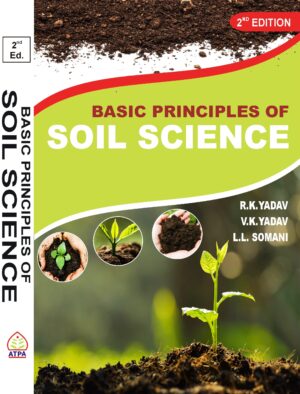MANURES, FERTILIZERS AND SOIL FERTILITY MANAGEMENT
₹1,639.00
AUTHOR: L.L. SOMANI
PUBLISHING YEAR: 2023
EDITION: 2nd
ISBN: 9789394777743
© All Rights Reserved
Description
ABOUT THE BOOK
We have already learned that much of the world’s soils are becoming less fertile. But what exactly does soil fertility mean? Some define soil fertility simply as the capacity of the soil to supply nutrients to the plant. Using the definition, a fertile soil one that contains an adequate supply of all the nutrients required for the successful production of plant life.
Fertilization is an important issue because it is needed in order to produce enough food for the increasing population from the decreasing cultivated land, but too much or inappropriate use can be detrimental to the environment.
A productive soil should contain all the essential plant nutrients in sufficient quantity and in balanced proportions. The nutrients must also be present in an available form before plants can use them. Inadequacy of any one of these elements will inhibit plants from growing to their full potential.
This principle is probably best summed by the “Law of the Minimum” Propounded by Justus von Liebig in themed-1800’s This law states that if one of the nutritive elements is deficient or lacking, plant growth will be poor even when all the other elements are abundant. Any deficiency of a nutrient, no matter how small an amount is needed, will hold back plant development. If the deficient element is supplied growth will be increased up to the point where the supply of the element is no longer the limiting factor. Increasing the supply beyond this point is not helpful, as some other element would then be in a minimum supply and become the limiting factor.
No course on soil fertility management would be complete without some discussion of the fundamental reason why we are so interested in managing soil fertility – providing adequate nutrition for plants. It is very important to understand the basic nutritional needs of plants before going on to discuss the best ways to provide these requirements.
This book has been designed to meet the basic requirement of the course recommended by the 5th Dean’s Ccommittee of ICAR. The book covers the whole syllabus in 26 chapters.
CONTENT
| NO. | TITLE | PAGE |
| PREANMBLE | 3-5 | |
| ABOUT THE BOOK | 6 | |
| SYLLABUS 5th DEAN’S COMMITTEE | 7 | |
| ABOUT THE AUTHOR | 7 | |
| CHAPTERS | ||
| 1 | Introduction | 9-15 |
| 2 | Organic Manures | 16-39 |
| 3 | Green Manuring | 40-57 |
| 4 | Fertilizer Recommendation Approaches | 58-75 |
| 5 | Integrated Nutrient Management | 76-88 |
| 6 | Chemical Fertilizers: Classification, Composition & Properties | 89-97 |
| 7 | Nitrogenous Fertilizers | 98-106 |
| 8 | Phosphatic Fertilizers | 107-119 |
| 9 | Classification of Potassic Fertilizers | 120-123 |
| 10 | Secondary & Micronutrient Fertilizers | 124-129 |
| 11 | Complex Fertilizers | 130-133 |
| 12 | Nano Fertilizers | 134-147 |
| 13 | Soil Amendments | 148-155 |
| 14 | Fertilizer Storage | 156-163 |
| 15 | Fertilizer Control Order | 164-174 |
| 16 | Soil Fertility and Plant Nutrition | 175-193 |
| 17 | Nutrient Transport to Plants | 194-205 |
| 18 | Factors Affecting Nutrient Availability | 206-217 |
| 19 | Chemistry of Soil Nitrogen | 218-235 |
| 20 | Chemistry of Soil Phosphorus | 236-247 |
| 21 | Chemistry of Soil Potassium | 248-256 |
| 22 | Chemistry of Secondary And Micronutrients
|
257-268 |
| 23 | Chemistry of Micronutrients | 269-290 |
| 24 | Soil Fertility Evaluation
|
291-313 |
| 25 | Methods of Fertilizer Recommendations to crops Crops
|
314-326 |
| 26 | Factor Influencing Nutrient Use Efficiency (NUE), | 327-337 |
| 27 | Methods of Fertiliser Application | 338-360 |
ABOUT THE AUTHOUR
Dr. L.L. Somani, Retired Director Resident Instructions, MPUAT, Udaipur has over 400 papers published in national and International Journals/Symposia proccedings, etc. and many number of books to his credit in different disciplines of agriculture. He held different position in MPUAT and has spreaded highly innovative ideas and programmes for the development of agriculture.
Additional information
| AUTHOR/AUTHORS | L.L. Somani |
|---|---|
| PAGES | 360 |
| BINDING | Hard Back |
| PUBLICATION YEAR | 2023 |





